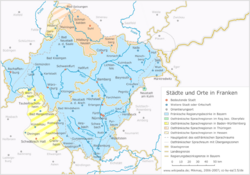Franconia

Franconia (German: Franken) is a historic region of Germany comprising the northern parts of the modern state of Bavaria and the area to its immediate west. The name survives in the Bavarian administrative regions of Lower Franconia (Unterfranken), Middle Franconia (Mittelfranken), and Upper Franconia (Oberfranken), but the original region extended further west to Speyer, Mainz, and Worms (west of the Rhine).
Franconia was one of the five original "younger" stem duchies that grew up in the Holy Roman Empire in the late 9th and early 10th centuries. The tribal nature of the region consisted in that it contained the Frankish territories east of the Rhine.
Contents |
Duchy of Franconia

Sometime around 906, Conrad of the Conradine dynasty succeeded in establishing his ducal hegemony over Franconia. At the failure of the direct Carolingian male line in 911, Conrad was acclaimed King of the Germans, largely because of his weak position in his own duchy. Franconia, like Alamannia, was not as united as Saxony or Bavaria and the position of duke was often disputed between the chief families.
Conrad had granted Franconia to his brother Eberhard on his succession; but when Eberhard rebelled against Otto I in 938, he was deposed from his duchy, and, rather than appoint a new duke from his own circle, Otto divided the threatening power of the duchy among the great ecclesiastics with and through whom he ruled, who had remained faithful to his cause: the Bishop of Würzburg and the Abbot of Fulda (939). They were later joined (1008) by a new bishopric erected on former ducal territory: Bamberg.
Thenceforth the great abbeys and episcopal seats that Saint Boniface and his successors had established in southwestern Germany had a monopoly on temporal office in Franconia, on a par with the counts of lands further west. They had another virtue in the Ottonian scheme: as celibates they were less likely to establish hereditary lineages. By contrast, Otto's son-in-law, Conrad the Red, whom he had installed as Duke of Lorraine in 944, extended his power base in Franconia.
Divided Franconia
In the High Middle Ages, Franconia came to be divided into two distinct regions, though these regions were not coherent territories with distinct governments. Rather, they were culturally different regions which came to be dominated by different political and religious forces and thus came under the de facto "rule" of different bodies.
Rhenish Franconia
Rhenish Franconia (Rheinfranken) was the western half of Franconia, immediately east of the Rhine. It was the heartland of the Salian dynasty, which provided four emperors in the 11th and 12th centuries: Conrad II, Henry III, Henry IV, and Henry V. Rhenish Franconia contained the ancient cities of Mainz, Speyer, and Worms, the latter two being countships within the hands of the descendants of Conrad the Red (the Salians). These counts were sometimes referred to informally, on account of the great power in the region, as dukes of Franconia.
Rhenish Franconia was actually governed, however, as a constellation of small states, like the free cities (Frankfurt and Worms), the bishoprics (Mainz, Speyer, and Worms), and the Landgraviate of Hesse. Alongside these powerful entities there were many smaller, petty states. In 1093, the Salian Franconian territories were granted as a fief to the Count Palatine of Aachen, a territory that would evolve into the important German principality of the Rhenish Palatinate. In this way, Rhenish Franconia was divided and extinguished.
Eastern Franconia
In 1115, Henry V awarded the territory of Eastern Franconia (Ostfranken) to his nephew Conrad of Hohenstaufen, who used the title "Duke of Franconia." Franconia remained a Hohenstaufen power base until 1168, when the Bishop of Würzburg was formally ceded the ducal rights in Eastern Franconia. The name "Franconia" fell out of usage, but the bishop revived it in his own favour in 1442 and held it until the reforms of Napoleon Bonaparte abolished it. It should be noted that the Bishop of Würzburg was more properly the Duke in Franconia (Herzog in Franken) rather than the Duke of Franconia (Herzog von Franken) during this time although both titles were used.
Modern Franconia

In 1803, Napoleon incorporated Eastern Franconia into Bavaria, to which it still belongs today. Culturally it is in many ways different from Bavaria proper, however. The ancient name was resurrected in 1837 by Ludwig I of Bavaria. During the Nazi period, Bavaria was broken up into several different Gaue, including Franconia and Main-Franconia.

While Old Bavaria is overwhelmingly Roman Catholic, Franconia is a mixed area. Lower Franconia and the western half of Upper Franconia (Bamberg, Lichtenfels, Kronach) is predominantly Catholic, while most of Middle and the eastern half of Upper Franconia (Bayreuth, Hof, Kulmbach) are predominantly Protestant. The city of Fürth in Middle Franconia historically (before 1933–1938) had a large Jewish population; Henry Kissinger was born there.
East Franconian German is very different from the Austro-Bavarian language. Most Franconians do not call themselves Bavarians, but their insistence on this point is generally a lighthearted matter in modern times. In fact, Franconians will most likely take umbrage at insults directed at Bavaria. Even if there is no Franconian state, red and white are regarded as state colours (Landesfarben) of Franconia.
See also
- East Franconian German
- Franconia (wine region)
External links
References
- Reuter, Timothy. Germany in the Early Middle Ages 800–1056. New York: Longman, 1991. ISBN 0-582-49034-0
- Cantor, Norman, The Civilization of the Middle Ages. 1993. ISBN 0-06-017033-6